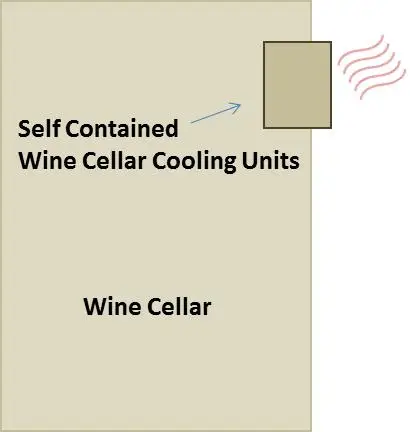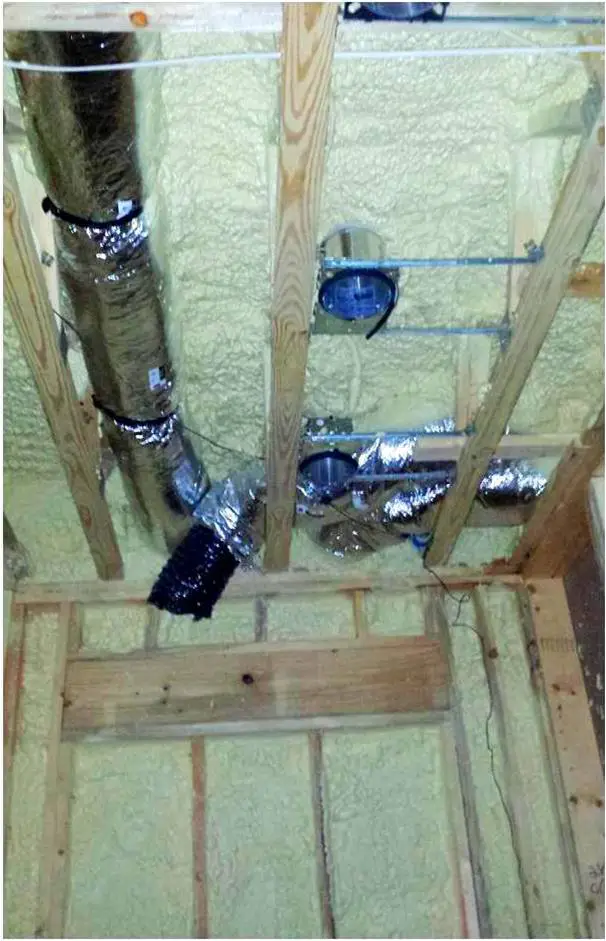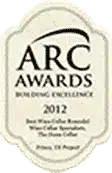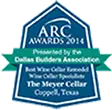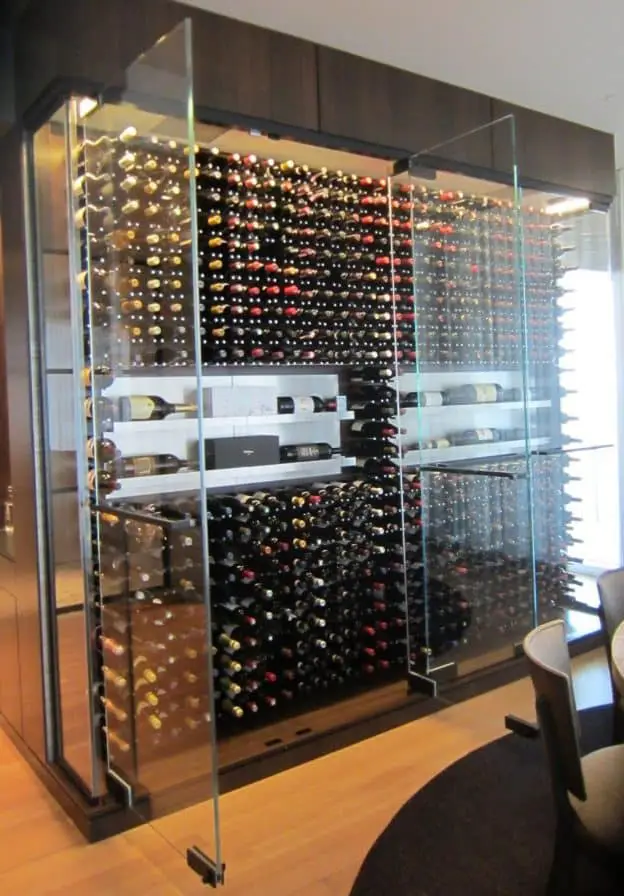
Custom Wine Cellar INstalled with Wine Guardian Ducted Self-Contained Water-Cooled Wine Cooling System
Working with Wine Cellar Specialists will ensure that the wine cooling unit is chosen carefully and installed correctly. Our team follows standard procedures essential for determining the right size and type of wine refrigeration unit for every project. Installing the wrong climate control system will result in wine storage problems and a waste of investment. We offer self-contained through-the-wall wine cooling units, the easiest to install of all refrigeration systems.
Self-Contained Through-the-Wall Wine Cellar Cooling Units: What You Must Know
When choosing the type and brand of wine cooling unit, Wine Cellar Specialists always sees to it that the equipment suits the needs of the owner. With various types of refrigeration systems available, it is easy to choose the wrong climate-control system. Therefore, it is crucial to work with an HVAC expert.
At Wine Cellar Specialists, our team is composed of experienced and knowledgeable HVAC technicians, and we handle the top brands of wine cooling equipment. We highly recommend the self-contained wine cooling systems because of the many benefits they offer.
Assessment and Heat Load Calculation: an Essential Step in Choosing the Ideal Wine Cooling System for Your Wine Cellar
When you call us to seek advice, we will ask you some questions to help determine which among the different types of wine cellar cooling systems will work best for you. The interview will also play a significant role in calculating the heat load.
Heat load calculation is a process that will determine the right size of the refrigeration unit need for your project. The information we gathered from you will be used for the correct sizing of the equipment. If any of the parameters of your wine cellar change, such as the type of insulation, size of the wine room, amount or type of glass, and a lot more, it could change the required size of the cooling unit for your wine cellar.
Correct Sizing and Installation of Wine Cellar Cooling Units
Regardless of the type of wine cooling system you choose, you must pick the right size for your wine cellar. Installing a cooling unit that is too big for the wine room can cause short cycles. It is caused by the equipment cooling quickly and not running long enough to pull the excess humidity from your cellar. Your wine cellar can have high humidity levels, which can trigger mold and mildew growth.
Installing a climate control system that is too small for your wine cellar will cause the unit to work constantly or harder to achieve the ideal wine storage conditions. It will pull too much humidity from the wine cellar, resulting in low humidity levels, which can cause quarks in the bottle to shrink and wine oxidation caused by air leakage. It can also cause the breakdown of your cooling system in the future and cause wine storage problems.
There are many types of wine cooling units on the market. When choosing a refrigeration system, it is essential to look for features that will suit your requirements. At Wine Cellar Specialists, all of our wine refrigeration systems are designed with functional features for cooling efficiency and installation flexibility. Self-contained wine refrigeration systems are engineered to cool wine cellars located in areas with milder climates.
Installation and Features of Self-Contained Wine Cellar Refrigeration Systems
Self-contained through-the-wall wine cellar cooling units are the easiest to install. You do not need an HVAC technician, saving you from spending on the professional fee. They are known as through the wall systems because they can be mounted between the studs of an existing wall. Keep in mind that you must decide which wall will be the best placement for your unit. whiIn a self-contained wine cellar cooling system, the condenser and evaporator are housed in one unit.
Interior Wall Installation
Most self-contained wine cooling systems are ideally mounted up high on an interior wall, six inches from the ceiling. It is vital to place it at the center of the wall to distribute the cold air evenly. It is not ideal to place the wine racks less than three feet in front of the climate control system.
Blocking the air coming from the unit will cause the air to bounce back into the return vent without proper circulation inside your wine cellar. Keep in mind that you need at least the length of the unit to provide space to get the unit inserted into the wall.
Some self-contained units vent the air from the bottom. In this type of installation, you will need enough room in front of the grill to get the equipment in during the installation. Installation of these units requires an adjacent room for heat and fan noise exhaust. One fan blows cold air into the wine cellar, while the other fan absorbs hot air and vents it to the adjoining or exhaust room.
The exhaust room should be well ventilated to accommodate the heat vented from the unit. If the unit is to be installed on an exterior wall, we must choose a model suited to operate at temperatures up to 105 degrees Fahrenheit.
The adjacent room must meet the requirements to perform its function. It must not have a temperature not exceeding 80 degrees Fahrenheit and must be at least the same size or twice the size of your wine cellar, depending on the recommendation of your chosen brand. It can be a garage, basement, mechanical room, or furnace room.
Exterior Through the Wall Wine Cellar Cooling Units
Some cooling systems, made as an exterior unit, can go through the wall to the exterior in some areas of the county. In this case, the temperatures of the location of the wine cellar will determine if this type of unit can be used. It is ideal for places where the temperatures range from 20 degrees to 110 degrees Fahrenheit. CellarPro and WhisperKOOL both have exterior self-contained cooling systems available.
Vapor Barrier, Insulation, and Drain Line: How They Affect the Efficiency of Wine Cellar Cooling Systems
When building refrigerated wine cellars, installing the proper vapor barrier and insulation is required. Without these installed in your walls, ceiling, and flooring (if aboveground), you cannot cool your wine room.
Most of the self-contained cooling systems come with drain lines that come out of the back of the unit and have to be either connected into a container or a drain that needs to be dumped occasionally. It is the reason why the adjacent room should be a mechanical room or a storage space.
Many refrigeration units are designed with built-in systems that evaporate most of the condensate but using a drain line is still recommended as a backup even if it is not needed.
The WhisperKOOL Slimline LS and WhisperKOOL Pro units are two examples of this style of climate control system. The Slimline, which is intended for very small wine rooms, looks good even when installed in a living space. Its drain line is located inside the wine cellar, different from the other through the wall units.
Self-contained units, like CellarPro 1800 Series and Houdini models, are specifically designed for some wine cabinets. The chosen unit will depend on the size of the cabinet and how it is built.
Advantages of Self-Contained Wine refrigeration Systems
There are many reasons self-contained wine cellar cooling systems are widely used in building refrigerated wine rooms. These units are less costly than the other types of refrigeration units.
Other advantages offered by self-contained wine cellar cooling units include functionality, efficiency, and ease of installation.
Findut if You Need One of Our Wine Cellar Cooling Units for Your Project
Wine Cellar Specialists will help determine the perfect system for your needs. Let us know what type of room is on the other side of your wine cellar walls. If you have an exterior wall, tell us what’s below the floor and above the ceiling. Knowing these will help us know whether a through-the-wall cooling unit will work for you or not.
We do not just sell high-quality wine cellar cooling systems. We also make sure that the right unit is installed in your wine room. To know which type and brand of wine cooling unit suits your needs, please call us at +1 (972) 454-0480

